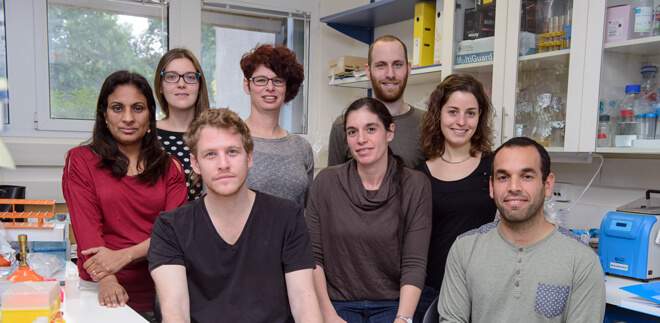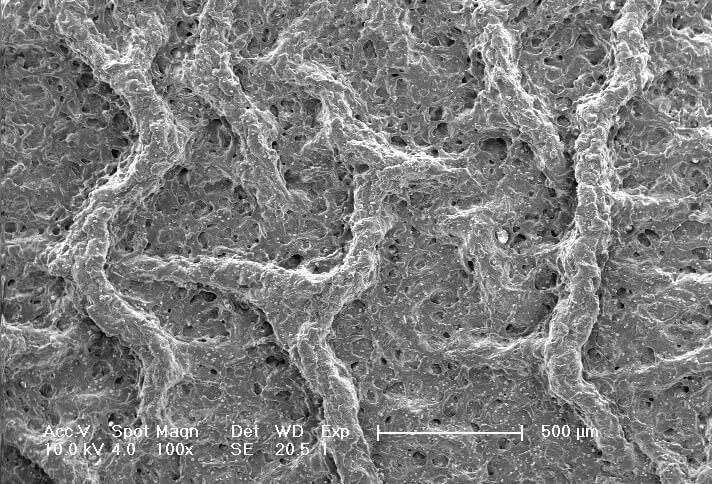עיתונאיות ועיתונאים, הירשמו כאן להודעות לעיתונות שלנו
הירשמו לניוזלטר החודשי שלנו:
Why is it that when bacteria gather together in large communal groups called biofilms, they gain super resistance to antibiotics? Recent research at the Weizmann Institute of Science provides an unusual explanation for this resistance: the bacteria erect a bone-hard fortress around their colony that repels the drugs. In the future, the findings, which recently appeared in a new journal from the Nature Publishing Group – npj Biofilms and Microbiomes – may help scientists devise better methods for treating many biofilm-associated microbial diseases.

Biofilms were known to be held together by organic molecules called exopolysaccharides. Dr. Ilana Kolodkin-Gal, who led the experiment together with Dr. Yaara Oppenheimer-Shaanan, a senior intern in her lab in the Molecular Genetics Department, realized, however, that these complex sugars cannot explain why these structures are so long-lasting, or why the bacteria in them are so able to resist antibiotics.
The research group grew common soil bacteria that form large, stable biofilms, placing them in different conditions and at varying levels of available carbon (e.g. carbon dioxide). The team then bleached the biofilms to clear away the organic matter. What was left were biominerals – structures made of calcium carbonate, the hard material found in corals and the spiny exteriors of starfish.
The researchers took these bacterial colonies to the Institute’s micro-CT X-Ray, which enabled them to view the three-dimensional mineral structures the colonies had built. “The micro-CT is normally used to detect structures the size of animal bones; since these biofilms are millions of times the size of a single bacterium, we could use this equipment to observe them,” says Kolodkin-Gal. “We succeeded thanks to the technical and scientific support of Dr. Vlad Brumfeld, who valiantly adapted this technique to our research question.”

These tests and others revealed that the calcium carbonate shield the bacteria produce both protects and gives structure to the biofilm. The scientists subjected these biofilms to ethanol – a potent poison – and found that the ones with the strongest calcium carbonate fortification were over 40 times better at resisting its effects than an unprotected bacterium. In addition, the researchers found that the mineral structures provide a sort of scaffold for the characteristic “wrinkles” in the colonies’ architectural style. These three-dimensional folds in the biofilm shape may enable the colony to grow by expanding its surface area, not only giving it room for new additions but enabling the colony to take in more oxygen and get rid of carbon dioxide waste.
Kolodkin-Gal: “Biofilms may produce these hard mineral structures – rather like the way in which corals build their reefs: Each bacterium produces and excretes granules of calcium carbonate, based on its communications with its neighbors and the way it senses its environment. Thus an intricate structure emerges, although there is no master plan or overseer.”
How do the bacterial genes for biomineralization, which the team identified, lead to the formation of the hard biofilm structures? Kolodkin-Gal and her team intend to continue researching this phenomenon. To this end, they have engaged the help of Profs. Steve Weiner and Lia Addadi of the Structural Biology Department. Weiner and Addadi are experts in biomineralization. Over the course of their careers, the two have unraveled the mystery of this process for a number of large, multi-celled organisms, for example spiny sea urchins, and now it seems their insights might be applicable to bacteria.

In addition to finding out how these fortress-like structures are made, the team is determined to understand how they can breached. “The biofilms that the tuberculosis bacteria form, for example, contribute to the fact that the treatment is effective only if taken for at least six months, while the disease is rapidly becoming resistant to many kinds of antibiotics. If we can prevent the bacteria from hiding behind the calcium carbonate structures, we might be able to kill them more quickly, easily and thoroughly,” says Kolodkin-Gal.
Ilana Kolodkin Gal's research is supported by the Benoziyo Fund for the Advancement of Science; the Abramson Family Center for Young Scientists; the Leo and Julia Forchheimer Center for Molecular Genetics; the Adelis Foundation; the Abraham and Sonia Rochlin Foundation; the Angel Faivovich Foundation for Ecological Research; the Lord Sieff of Brimpton Memorial Fund; the Larson Charitable Foundation; Ayala Benjamin-Mashat, Switzerland; Lois Rosen, Los Angeles, CA; Dan and Susan Kane, Westlake Village, CA; the late Rudolfine Steindling; and the estate of Samuel and Alwyn J. Weber. Dr. Koldkin-Gal is the incumbent of the Rowland and Sylvia Schaefer Career Development Chair in Perpetuity.